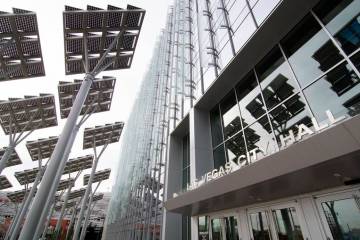Most of the time, infrastructure stories are just dusty dry and move at a glacial pace. It’s true of water stories and public transportation stories and, until recently, energy stories.
But in the past few weeks, we’ve been treated to some energy stories that pack a jolt:
▶ There’s the opening this week of the Copper Mountain Solar 3 solar plant in Boulder City, a small but meaningful shift toward renewable energy;
▶ And there’s the legislative stalemate over net metering. As Craig Ruark capably demonstrates in a story on this edition’s cover, this is a struggle that could derail rooftop solar, both as a power source and as an engine for job creation in Nevada;
▶ But the one that has me charged up is the tale of Switch’s impending exit from the public power grid.
As a major power consumer, Switch’s decision to fend for itself has a ripple effect on the rest of us as ratepayers. They need to shoulder a share of the cost of the infrastructure that was set up to serve the community’s needs, based on the assumption Switch would be one of those users. It’s clearly not as simple as a single user changing cell phone providers.
State regulators have set the exit price at $27.7 million; Switch says the number should be $18.5 million. Whatever. That’s a matter for negotiation and possibly litigation but someplace between those poles is the ‘right’ number. That’s work for a flight of Philadelphia lawyers.
Let’s turn our attention away from that issue and consider the underlying facts here: Switch — and the three casino giants who are on the same path — have made the business calculation that they can supply all their power needs more cheaply.
How cheaply? Constellation Energy, the reported supplier of choice, isn’t talking. So let’s do some back-of-the-envelope calculations and see where that leads us.
If the deal pencils for Switch to be willing to pay, let’s say, $20 million to get out, what kind of return on that investment is Switch expecting? Residential solar buyers are being told a seven-year payback is reasonable. Switch has sharper pencils so let’s guess the number is five years. That means they need to save $4 million a year. The number is likely higher because they’d have to amortize any capital costs related to the Switch switch. But let’s forget that for the moment.
Switch is using 1.35 percent of the power; that’s roughly one-75th. So if we all were in a position to move to a cheaper supplier, we could be saving, hmmm, $4 million times 75 – yikes, that’s $300 million.
If you’re reading that as an indictment of NV Energy, you’re missing the point. That publicly traded company is a for-profit business in a highly regulated field. Yes, they keep filing rate hike requests but they only get what state regulators allow. Besides, the existing price structure does not appear out of line. After all, the federal Department of Energy calculates Nevada’s electric rates as just below the mid-point of Mountain states, a third less than California’s and almost half of the Connecticut rate. We won’t even discuss the absurd cost of power in Hawaii and Alaska.
Yet here we are with the reality that another supplier can significantly undercut NV Energy’s rate to supply customers – albeit large customers – in Nevada.
The problem can’t be NV Energy’s bottom line. The rate of return is controlled. So it seems like time for Nevada regulators to sharpen their pencils and see where the fat lies in the rate structure.
The alternative is indeed a hideous Wild West scenario in which micro-grids, a favorite of greenies, spring up hither and yon offering a better deal and the concept of a regulated core utility is destroyed. And nobody is going to like living in a cut-throat market for one of modern life’s indispensible commodities.
OK, so all of this may move at a glacial pace. But it’s neither dusty nor dry. It’s real money and we’re looking at a real life-and-death issue for Nevada. Simply put, it’s time we stopped yawning and take energy issues seriously.






